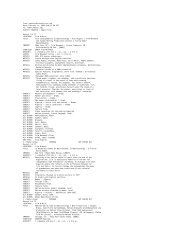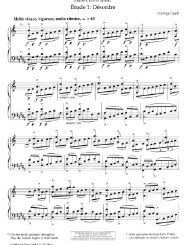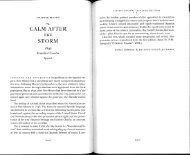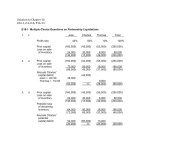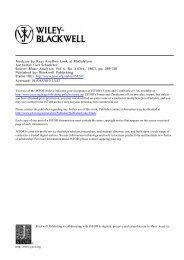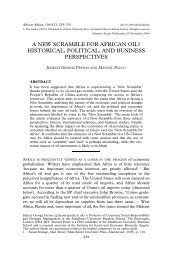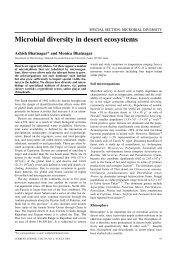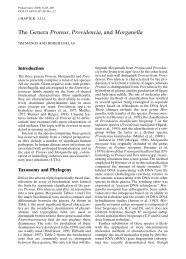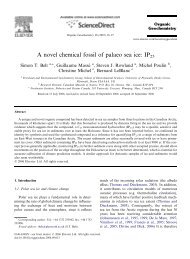The Genus Serratia
The Genus Serratia
The Genus Serratia
You also want an ePaper? Increase the reach of your titles
YUMPU automatically turns print PDFs into web optimized ePapers that Google loves.
CHAPTER 3.3.11 <strong>The</strong> <strong>Genus</strong> <strong>Serratia</strong> 227<br />
and nitrofurantoin and are usually susceptible to<br />
carbenicillin, third-generation cephalosporins,<br />
chloramphenicol, streptomycin, kanamycin, gentamicin,<br />
tobramycin, amikacin, trimethoprim/<br />
sulfamethoxazole, fosfomycin, nalidixic acid, and<br />
other quinolones (P.A.D. Grimont, unpublished<br />
observations). Clinical strains harboring plasmids<br />
often show additional resistance to various<br />
antibiotics (Farrar, 1980; Hedges, 1980), with a<br />
single plasmid being able to confer resistance to<br />
one to eleven antibiotics (Hedges, 1980; Olexy et<br />
al., 1982). Mutants resistant to nalidixic acid are<br />
often encountered in urology wards, and these<br />
mutants are often resistant to other quinolones.<br />
<strong>The</strong> antibiotics most often active against nosocomial<br />
strains of S. marcescens are amikacin, moxalactam,<br />
and cefotaxime. However, some strains<br />
may produce enzymes inactivating amikacin<br />
(Farrar, 1980) or may overproduce a class C βlactamase<br />
(low-level resistance to cefotaxime<br />
and some other third-generation cephalosporins),<br />
which may combine with decreased<br />
permeability to β-lactams (high resistance to<br />
cefotaxime and some other third-generation<br />
cephalosporins) (Hechler et al., 1989).<br />
Compounds Produced by <strong>Serratia</strong><br />
Pigments<br />
Prodigiosin, a nondiffusible red pigment, is a secondary<br />
metabolite formed by the enzymatic<br />
condensation of 2-methyl-3-amylpyrrole (MAP)<br />
and 4-methoxy-2,2′-bipyrrole-5-carboxyaldehyde<br />
(MBC), leading to a tripyrrole derivative, 2methyl-3-amyl-6-methoxyprodigiosene(Williams<br />
and Qadri, 1980). Little is known about the<br />
biosynthetic pathways of MAP or MBC, except<br />
that a proline molecule is incorporated intact<br />
into one of the pyrrole groups of MBC (Williams<br />
and Qadri, 1980). Pigment synthesis require air,<br />
probably molecular oxygen. In the genus <strong>Serratia</strong>,<br />
prodigiosin is only produced by strains of S.<br />
marcescens, S. plymuthica, and S. rubidaea. In S.<br />
marcescens, prodigiosin is produced by biogroups<br />
A1 and A2/6 and never by biogroups A3,<br />
A4, A5/8, or TCT (Grimont, P. A D., 1977). Nonpigmented<br />
strains of biogroups A1 or A2/6 are<br />
often blocked in the synthesis of either MAP or<br />
MBC (Grimont, P. A. D., 1977; Williams and<br />
Qadri, 1980). Strains in the nonpigmented biogroups<br />
are likely to lack the condensing enzyme<br />
(Ding and Williams, 1983). Some genes encoding<br />
prodigiosin biosynthesis were cloned by Dauenhauer<br />
et al. 1984 and expressed in Escherichia<br />
coli. <strong>The</strong> clones obtained had acquired the ability<br />
to condense MAP with MBC or to produce MAP<br />
in addition to the condensing enzyme.<br />
Strains belonging to the ubiquitous biotype A4<br />
can synthesize a pink diffusible pigment called<br />
pyrimine (Grimont and Grimont, 1984; Williams<br />
and Qadri, 1980). Pyrimine, or ferrorosamine A,<br />
is a ferrous complex of L-2(2-pyridyl)-D′-pyrroline-5-carboxylic<br />
acid, a secondary metabolite<br />
also known to be produced by Erwinia rhapontici<br />
(Feistner et al., 1983).<br />
A yellow diffusible pigment, 2-hydroxy-5carboxymethylmuconic<br />
acid semialdehyde, is<br />
produced from the meta cleavage of 3,4dihydroxyphenylacetic<br />
acid (3,4-DHP) by the<br />
enzyme 3,4-DHP 2,3-dioxygenase (Trias et al.,<br />
1988). This enzyme is induced by tyrosine in all<br />
S. marcescens strains. However, presently only S.<br />
marcescens strains of biotype A8a, which have<br />
lost the ability to grow on aromatic compounds,<br />
can produce the yellow pigment. An uncolored<br />
muconic acid, β-cis-cis-carboxymuconic acid,<br />
can be produced by the ortho cleavage of 3,4dihydroxybenzoate.<br />
Biosurfactants<br />
Both pigmented and some nonpigmented strains<br />
of <strong>Serratia</strong> marcescens produce a biosurfactant<br />
that can act as a wetting agent. This wetting agent<br />
is produced in large amounts at 30°C but not at<br />
37°C during the stationary phase of growth.<br />
Three aminolipids, designated W1 to W3 and<br />
having the wetting activity, were separated by<br />
thin-layer chromatography (Matsuyama et al.,<br />
1986). W1 was identified as serratamolide, a<br />
cyclodepsipeptide earlier discovered by Wasserman<br />
et al. 1961.<br />
Fatty Acids<br />
<strong>The</strong> major fatty acids components in whole-cell<br />
methanolysates of <strong>Serratia</strong> species are 3-hydroxytetradecanoic,<br />
n-hexadecanoic, hexadecanoic,<br />
and octadecanoic (not separated from octadecadienoic)<br />
acids. <strong>The</strong>se contribute 50–80% of the<br />
component fatty acids in each strain. Significant<br />
quantities are also contributed by ntetradecanoic<br />
acid (Bergan et al., 1983).<br />
Flavors<br />
Alkyl-methoxypyrazines are responsible for the<br />
potatolike odor produced by all strains of S.<br />
odorifera and S. ficaria and some strains of S.<br />
rubidaea. <strong>The</strong> major alkyl-methoxypyrazine produced<br />
by these <strong>Serratia</strong> strains is 3-isopropyl-2methoxy-5-methylpyrazine.<br />
Minor compounds<br />
include 3-sec-butyl-2-methoxy-5(6)-methylpyrazine<br />
and 3-isobutyl-2-methoxy-6-methylpyrazine<br />
(Gallois and Grimont, 1985). Production of<br />
these three molecules by other bacterial species<br />
has never been observed. <strong>The</strong> food industry<br />
uses pyrazines to improve the flavor of some<br />
products.



